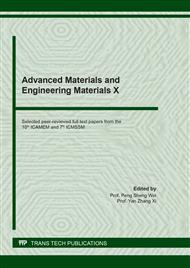p.375
p.382
p.387
p.392
p.401
p.407
p.413
p.419
p.429
Experimental Study on Biological Treatment of Copper in Acid Mine Drainage after Iron Removal
Abstract:
Acid mine drainage is characterized by low pH value, many types of heavy metals, high concentration of heavy metals and great environmental damage. Copper precipitation by sulfate reducing bacteria is a common method. In this experiment, the AMD after iron removal was treated by an upflow anaerobic bioreactor. The effects of HRT, carbon source type, carbon source dosage and reactor temperature on the operation of the reactor were studied. The optimum process parameters were determined: HRT was 12h, formic acid was used as carbon source and the dosage was 0.5g/L, and the temperature was 30 °C. Under the process conditions, the Cu concentration in the reactor effluent decreased to 0.043mg/L, and the recovery rate of Cu metal was 99.9%. The mechanism of copper deposition in the reactor was studied by characterization of the structure and morphology of the precipitated product and the analysis of the microbial community structure in the effluent of the reactor.
Info:
Periodical:
Pages:
401-406
Citation:
Online since:
November 2021
Authors:
Price:
Сopyright:
© 2021 Trans Tech Publications Ltd. All Rights Reserved
Share:
Citation:


